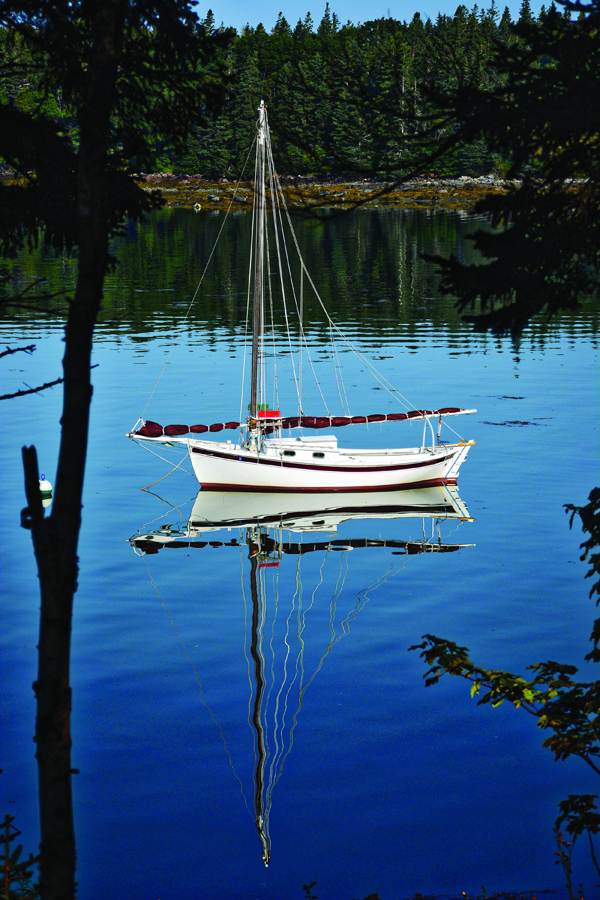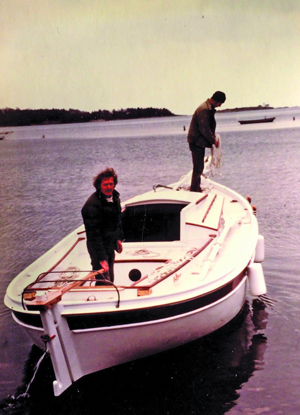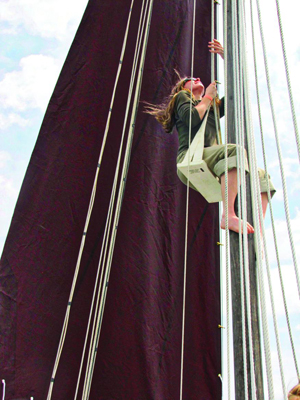 Chimera
Chimera floats on her mooring in Davis Cove, looking out to Muscongus Bay.
Article and Photos By Chrisso Rheault
On the coldest day of 2014, in the midst of the polar vortex, I happily clambered up a ladder, crawled under heavy plastic, and, using the flashlight in my phone to see, began messing around with brass screws. I could not have been happier.
Taking advantage of heated workshop space, I had crawled into the newest member of our boat family to take out all the removable pieces of cabin furniture for refinishing. As I rummaged for the right screwdriver, I reached over to the battery switch and turned on the interior lights. Instantly the cabin went from storage gloom to cozy. A sailboat’s cabin, and specifically a wooden sailboat’s cabin, has an indefinable quality, which, if done right, makes you feel both at home and ready for the next big thing.
Chimera has had that effect on me since the very first time I sat on her V-berth as an adult.

The 26-foot Lubec sloop on launching day
in November 1976, Rockport Harbor.
Some 40 years ago, my parents moved to Maine from Washington, D.C. They had met in the Solomon Islands, but got married in Rockport, Maine. The ceremony took place on a balcony overlooking the harbor and a long, red boatshop. Eighteen months or so later, they moved to Rockport after buying that shop and the business it contained, Penobscot Boat Works.
The yard had been known for building salty looking, trawler-style cabin cruisers known as Penbos. My father, Andre Rheault, bought the business from Bob Lane who had begun building a series of traditional sailboats based on the Quoddy Pilot—a 32-foot-long, double-ended and gaff-rigged pinky boat, strip-built and sheathed in epoxy. A few years later, in 1976, my father commissioned Ted Brewer to draw up a shorter version of the Quoddy, to be known as the Lubec. The Lubec sloop, at 26 feet, is a solid, comfortable daysailer with room for short cruising. It has no bulkheads, which makes the cabin open and airy.
Venture, the first of the Lubecs, was launched as a spec boat in November 1976. Three months later my father received a letter from a gentleman in Philadelphia named Phil von Hemert who was interested in having a boat built. When he heard about
Venture, he bought her instead, and changed her name to
Chimera.
Chimera would have a home with Phil in Friendship, Maine, for the next 30-odd years.
Coincidentally in 1976, my parents bought a small place in Cushing, Maine, just east of Friendship. Our summers were spent there in a fleet of smaller boats. We would often see
Chimera on her mooring or out sailing.
I began to have a hankering for a bigger boat some years ago. Our ‘fleet’ consisted of a smattering of rowboats, canoes, a Doughdish 12½, and a Pulsifer Hampton. More than enough boats for most people, I know. But I had dreams of overnight trips. When I saw
Chimera listed for sale about eight years ago I almost made the call, until family members told me “the last thing we need is another boat.”

The author and his faithful boat dog Gibson sailing
across the mouth of the St. George River, on the
way home from a trip to Port Clyde for ice cream.
Then, in the summer of 2012 I was driving to Thomaston with a friend and her daughter when we passed the shed where
Chimera sat lingering in the back. The three of us talked about the boat and the conversation went something like this: ‘My father’s yard built her,’ I said. ‘Let’s take a look.’ ‘She’s for sale?’ ‘I think so.’ ‘We should buy her, then we could take friends out sailing.’
A few inquiries revealed that von Hemert had died the previous winter and the family was looking to sell the boat. He had not been able to sail her for a number of years, so she had been in storage. But his love for the boat was such that she had new sails, and various other improvements had been made. One of the best discoveries was when I found that her original engine had been replaced with a Yanmar 3GM, that ultimate example of reliability, one of which powers our Hampton, and with which I was intimately familiar.
Come spring of 2013, I was in touch with the yard about launch dates and what she would need. Early July saw us stepping the mast at the public landing before setting off in a thickening fog down the St. George River. That first trip was under power and with the tide. We made good time and got home just as the fog really rolled in. At this point she had her mast, but not much other rigging. Indeed, I was about to begin the steep learning curve of rigging, lacing sails, and setting up this boat. While the boat was still on the dock in Thomaston I had spent a few days cleaning the cabin, going through the systems, and checking the mechanicals. It took another week to figure out which block went where for the mainsheet, and to identify each of the seemingly dozens of lines coming from the top of the mast.
In addition to the rigging, there were all the other oddities of an older boat without an owner’s manual. In this case there was the added “bonus” of a boat that had been owned and loved for decades by a man with a creative engineer’s brain: boards with bronze end brackets, which fit between the cockpit seats to make it into a full bed; Phil’s clever offset boom-crotch; the ladder steps he had built onto the rudder.

Friend and valiant crew member Melanie Dees
ascends in a bosun’s chair to unjam the jib.
Every trip taught me something. On my first outing, the jib sheet jammed at the top of the mast. We promptly sent a valiant crew member up the mast; after a few more outings I realized that there were downhauls mounted on the bowsprit. Another outing taught me that even a full-keel sailboat could catch one of Muscongus Bay’s notorious lobster-pot toggles under sail. During that same ad
Venture I learned that a 26-foot, 5.5-ton boat doesn’t turn or change momentum in quite the same manner as a Laser.
Mostly, though,
Chimera has taught me what any good sailboat teaches us: life is to be enjoyed and to be shared. As a boatbuilder friend once said,
Chimera has room for two, maybe two and a half people to sleep on board, but she has lots of room for friends to visit. During a sail to Rockland that first summer, a breeze picked up and by the time we were passing Tenant’s Harbor we were making 5-6 knots as comfortably as you could want.
Whenever I imagined moving into a bigger boat, I knew that a boat just under 30 feet would be perfect. I think my father knew that as well when he commissioned the Lubec. In correspondence about the boats he describes them as “just right” and a “well sailing boat you will enjoy.” I have always had a hankering for traditional-looking boats—no doubt those I saw as a child influenced my tastes. Most of all, I am happy to continue the tradition of boating begun in that long red boatshop on Rockport Harbor.
Chrisso Rheault is a historian, teacher, and writer who splits his time between Maine and Louisiana. He is tracking down boats built by Penobscot Boat Works (
eb13@mac.com).
Secondary Title Text
The boat his father built comes home
 Chimera floats on her mooring in Davis Cove, looking out to Muscongus Bay.
Chimera floats on her mooring in Davis Cove, looking out to Muscongus Bay.
 The 26-foot Lubec sloop on launching day
in November 1976, Rockport Harbor.
The 26-foot Lubec sloop on launching day
in November 1976, Rockport Harbor.
 The author and his faithful boat dog Gibson sailing
across the mouth of the St. George River, on the
way home from a trip to Port Clyde for ice cream.
The author and his faithful boat dog Gibson sailing
across the mouth of the St. George River, on the
way home from a trip to Port Clyde for ice cream.
 Friend and valiant crew member Melanie Dees
ascends in a bosun’s chair to unjam the jib.
Friend and valiant crew member Melanie Dees
ascends in a bosun’s chair to unjam the jib.






